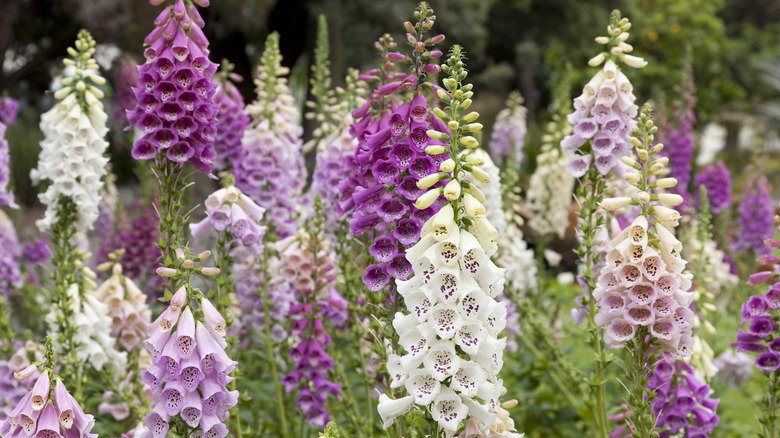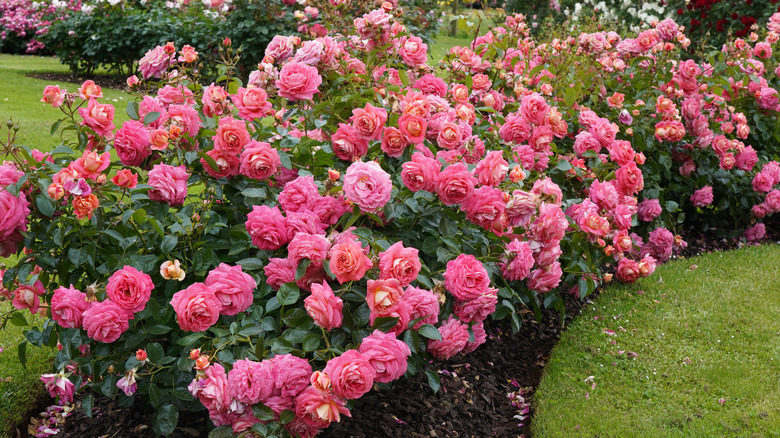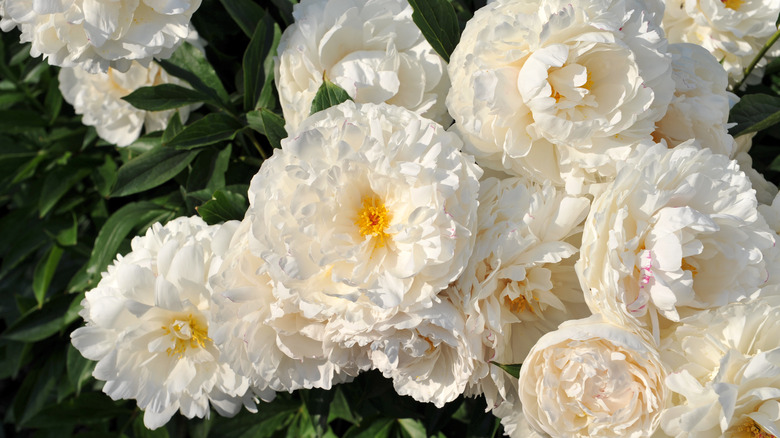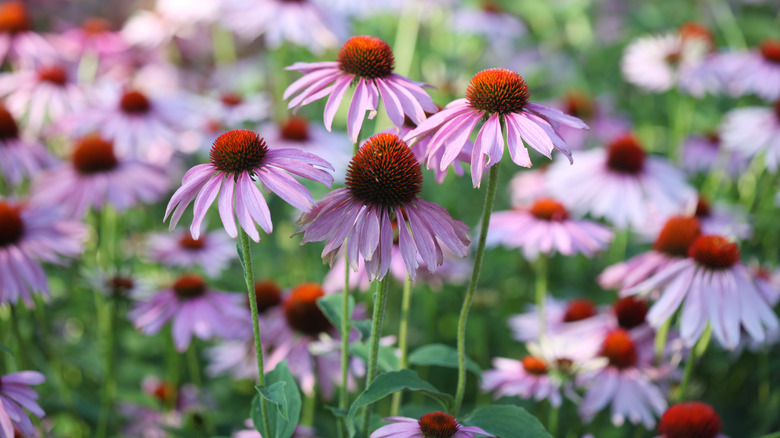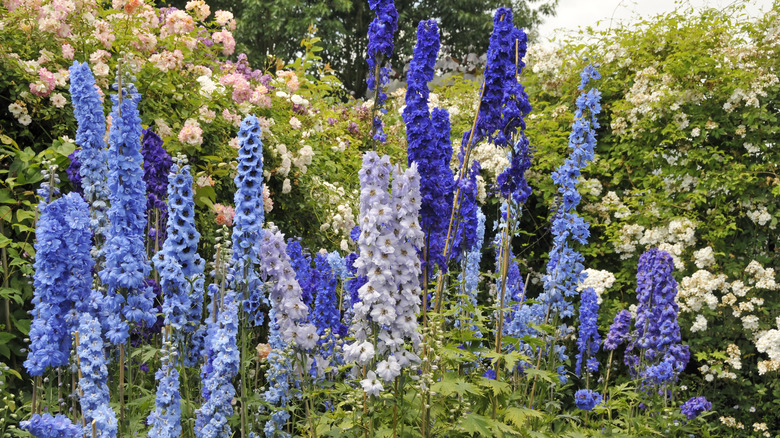Popular Garden Flowers That Pair Beautifully With Foxglove
Foxglove (Digitalis) is an eye-catching biennial flowering plant that is popular for several reasons. Its tall, sturdy stems can reach up to 5 feet in height, and it has a stunning display of tubular flowers in shades of white, purple, pink, red, and yellow, often decorated with speckles. The downward-facing blooms grow in attractive clusters and often appeal to bumblebees and other beneficial insects. Because of their height, these beauties look incredible in the back row of a cottage garden or along mixed borders. If you want to create a visually appealing garden ranging in colors and height, foxglove is a good place to start. Luckily, its relatively easy care requirements means there are several popular companion plants with similar needs, including roses, peonies, coneflower, and delphiniums.
Companion planting benefits your garden by taking advantage of complementary qualities. For example, one species may repel deer, another may choke out nearby weeds, creating a harmonious, naturally thriving ecosystem. Foxglove prefers full to partial sun, though it can depend on your climate. It likes a little afternoon shade in areas with hot temperatures but does well in full sun in cooler climates. It thrives in slightly acidic, well-draining, and evenly moist soil and is best-suited to USDA zones 4 to 9.
Add versatility to your garden with roses
Rose (Rosa) is a large genus with hundreds of species in nearly any shape, color, and growth habit you can think of. Whether you want a groundcover, shrub, or climbing vine, there's a rose variety that will meet your needs. Roses, with their timeless rosettes, contrast beautifully with the tall, bell-shaped foxglove. Because Rosa is such a versatile species, you can pair them in several ways, giving you endless possibilities for your garden design. Roses, like foxgloves, attract several beneficial insects. With these two beauties, you can easily start a pollinator garden that not only adds visual appeal but helps the environment. As a bonus, there are several native rose species, such as the Carolina rose (Rosa Carolina), to choose from. Avoid invasive species like the rapidly spreading multiflora rose (Rosa multiflora) to avoid choking out native plants.
Roses thrive when planted in a sunny location where they will get at least 6 hours of sunlight a day in well-draining, slightly acidic soil. They require plenty of water, so make sure to thoroughly soak the soil so it reaches the roots. Like foxgloves, you want to avoid getting the foliage too wet as it can promote fungal diseases. To keep the blooms looking their best, give them fertilizer in early spring and feed them again around mid-summer. Once your roses start blooming, you can prolong flowering by keeping up with deadheading.
Pair peonies with foxglove to add stunning contrast
Roses aren't the only romantic flowers for your garden; peonies will also add the perfect fairytale touch. There are over 30 species to choose from, all with showy blooms and an attractive fragrance. Although most peonies are herbaceous perennials, there are a few woody shrub varieties to choose from as well. Peonies are medium-sized plants growing about 3 to 4 feet tall and wide. Like roses, their lush rosettes provide the perfect contrast to the elongated look of foxgloves. Extremely versatile, peonies make attractive backdrops or garden borders and match the aesthetic of many garden styles ranging from cottage to formal gardens.
To successfully grow peonies, choose a spot in your yard that receives full sun to get the best blooms. Make sure the soil is well-draining, preferably with a slightly acidic 6.0-7.0 pH level. While it's not impossible to transplant peonies, they don't always respond well. It's a good idea to choose the right site with care to avoid disturbing their large root systems in the future. In addition to providing the right growing conditions, aim for an area that's not too close to trees or shrubs so they won't need to compete for nutrients. It's also a good idea to provide shelter to protect them from strong winds. When grown in the right conditions, peonies will return to brighten your garden for years.
Plant coneflower for a low-maintenance companion plant
Coneflowers (Echinacea) are popular plants that are hard not to love for several reasons, including their beautiful blooms. This herb has likely been used medicinally for over 400 years for issues like treating wounds, though now, it's most commonly used in teas. Even if you don't plan on turning your flowers into a tasty warm beverage, you can still enjoy the benefits they offer the environment. When in bloom, coneflowers attract pollinators like butterflies and bees, while their seeds will bring birds into your garden. Their daisy-like shape brings in other beneficial insects, like ladybugs. Natural predators like lady beetles will attack common pests, like aphids, helping to keep the entire garden pest-free. Growing up to 4 feet tall, they contrast beautifully with foxgloves and make an eye-catching border flower or mixed garden plants.
To grow and care for coneflowers, make sure they get at least 6-8 hours of direct sunlight. Although they can tolerate some shade, they'll bloom more efficiently when they're in a location that allows them to bask in the sunshine. Echinacea isn't too picky about soil types and does well whether it's sandy or rocky, alkaline or acidic. As long as the soil is well-draining, they'll be happy, though they prefer slightly acidic soil — which, conveniently, is exactly what foxgloves like to live in. Although coneflower is drought-tolerant once established, you'll still need to give your plants regular showers during the growing season and periods of drought.
Create more vertical dimension with delphiniums
Tall spikes of colorful tubular flowers can be hard to resist. Delphiniums, like foxgloves, add stunning pops of colors like pink, purple, blue, yellow, and white that are also attractive to hummingbirds and pollinating insects. They're a popular choice for gardeners who wish to add more vertical dimension, as they can grow up to 6 feet tall. If your goal is to create a cottage garden style, you can't go wrong with an array of delphiniums and foxgloves as a back border or a focal point of your floral display. Because they have a bitter taste and are toxic to humans and animals, deer and rabbits will steer clear. So, if you plan on adding a species like roses, which deer love to snack on, these unpalatable plants will help deter them.
If you struggle to keep your plants alive, delphiniums are flowers that are relatively easy to care for. While they love soaking in the sun for up to 8 hours each day, they can benefit from afternoon shade in hot climates. They don't mind most soil types, so as long as it's well-draining, they'll be happy. Although they can be somewhat drought-tolerant, your delphiniums will thrive if given consistent moisture. For the best blooms, feed them a slow-release fertilizer at the beginning of spring and the middle of summer.
